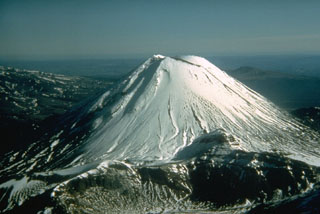Report on Tongariro (New Zealand) — 19 August-25 August 2015
Smithsonian Institution / US Geological Survey
Weekly Volcanic Activity Report, 19 August-25 August 2015
Managing Editor: Sally Sennert.
Please cite this report as:
Global Volcanism Program, 2015. Report on Tongariro (New Zealand) (Sennert, S, ed.). Weekly Volcanic Activity Report, 19 August-25 August 2015. Smithsonian Institution and US Geological Survey.
Tongariro
New Zealand
39.157°S, 175.632°E; summit elev. 1978 m
All times are local (unless otherwise noted)
On 19 August GeoNet reported that activity at Tongariro's Te Maari Craters had declined significantly since the eruption in 2012, with data suggesting that unrest associated with the eruption was over. The Volcanic Alert Level was lowered to 0 (on a scale of 0-5). The Volcanic Alert Level for Ngauruhoe is separate and had been lowered to 0 on 20 April.
Geological Summary. Tongariro is a large volcanic massif, located immediately NE of Ruapehu volcano, that is composed of more than a dozen composite cones constructed over a period of 275,000 years. Vents along a NE-trending zone extending from Saddle Cone (below Ruapehu) to Te Maari crater (including vents at the present-day location of Ngauruhoe) were active during several hundred years around 10,000 years ago, producing the largest known eruptions at the Tongariro complex during the Holocene. North Crater stratovolcano is truncated by a broad, shallow crater filled by a solidified lava lake that is cut on the NW side by a small explosion crater. The youngest cone, Ngauruhoe, is also the highest peak.
Source: GeoNet

